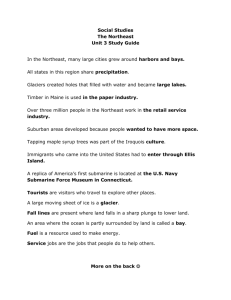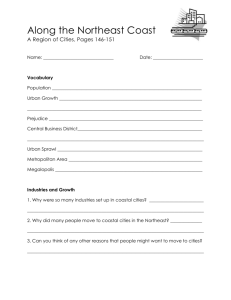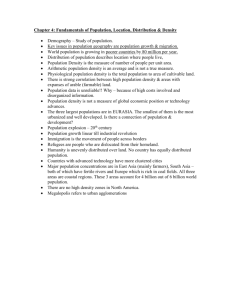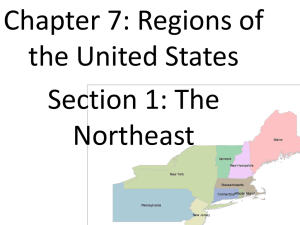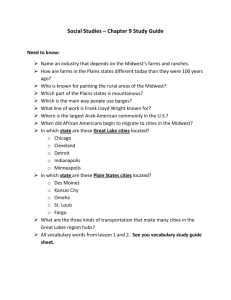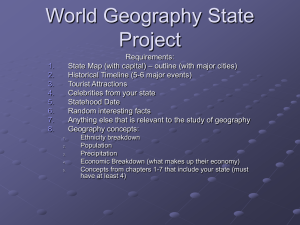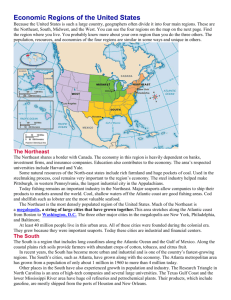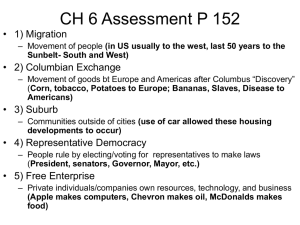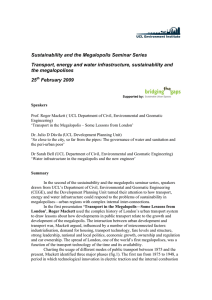Chapter 7: Regions of the US Section 1 * The Northeast
advertisement
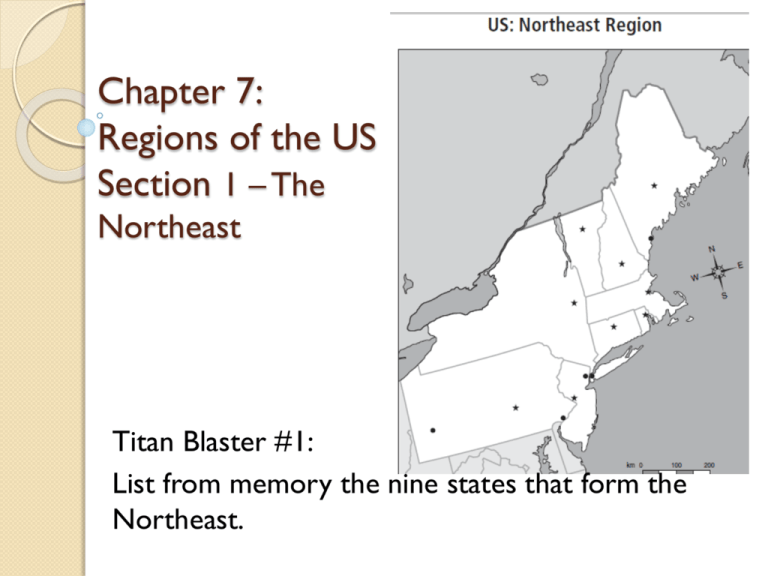
Chapter 7: Regions of the US Section 1 – The Northeast Titan Blaster #1: List from memory the nine states that form the Northeast. Physical Characteristics Maine is known for its craggy coastline. Physical Characteristics New York has Niagara Falls. New York City is the cultural capital of US. Physical Characteristics Boston and Philadelphia offer details about our nation’s history. Natural Resources The Northeast has few natural resources. Due to the Appalachian Mountains, most parts of the NE are rugged. Pennsylvania has coal mines. Natural Resources The most valuable resource of the Northeast is the waters. There are plentiful fish in the Grand Banks just off the coastline. A Leader in Industry The mountains that hurt farming help manufacturing by creating fast-moving rivers like the Connecticut and Hudson. These aided in producing power to run machinery by using water wheels. Factories were built by waterfalls. These factories used the waterways to ship their goods across the world. The Megalopolis Cities along the Atlantic coast started as harbors, but grew into areas of business. As businesses grew, so did the need for workers. The Megalopolis Many Americans and Europeans went to the Northeast looking for jobs. The Megalopolis Over time, the area spread into a megalopolis – a very large city. The Megalopolis The area from Boston to Washington DC is considered a megalopolis of over 40 million people. This is leading towards a shortage of water, sewage systems, and waste disposal. Population declines hurt areas like Philadelphia by forcing the local government to raise taxes to pay for services. Chapter 7: Regions of the US Section II – The South Titan Blaster #2: List four benefits to living in The South. General characteristics The South includes the confederate states and five others as well as Washington DC. The climate is humid, subtropical. Most Southern states have mixed forests. There is very fertile soil throughout the South. Today, farming is still very important in the South. Linking Climate to Vegetation Mangroves are tropical trees that grow in swampy ground along coastal areas. Bayous are marshy inlets of lakes and rivers in Louisiana. The Everglades are a large swampland covered with tall grasses in Florida. In the 1840s, many textile mills were built on rivers in the Carolinas. These mills were built near the falls and cotton fields. Linking Resources to Industry The fall line is an imaginary line between the Appalachian Mountains and the Atlantic coastal plain. Here rivers and streams form waterfalls and rapids as water heads to the ocean. Gulf coast oil is a major industry. A Changing Region The US Space Program has locations in Texas, Florida, and Mississippi (The Stennis Space Center). A Changing Region Fewer labor unions and cheaper land prices than the Northeast led to many businesses relocating to the South. The Sunbelt is an area between the Carolinas to southern California. Southern Population Over half of the nation’s African-American population lives in the South. Many Hispanics have moved up to the South. Texas is second in total population in the USA. Three of the largest cities in the US are in the South: Houston, Dallas and San Antonio. Southern Population Washington DC was a planned city. Chapter 7: Regions of the US Section III – The Midwest Titan Blaster – Match the states with their cities: Iowa Minnesota Ohio Nebraska Missouri Kansas Wisconsin Illinois Indiana Michigan a. Cincinnati b. Chicago c. Detroit d. Omaha e. Des Moines f. Minneapolis g. Milwaukee h. Indianapolis i. Jefferson City k. Topeka The Midwest An Agricultural Economy The dark-colored organic material in soil that results when plants and animals die and decay is called humus. An Agricultural Economy The majority of the wheat output in the Midwest has led to it having the title “the nation’s breadbasket.” An Agricultural Economy A growing season is the average number of days between the last frost of spring and the first frost of fall. The Changing Face of American Farms Small family farms have been replaced by much larger, big business farms. • A grain elevator is a tall building equipped with machinery to load, clean, mix and store grain. The Changing Face of American Farms The grain exchange is a place where buyers and sellers deal for grain. The Changing Face of American Farms Today’s assignment: page170 #2-5; today’s guided reading worksheet and draw, color and label the map on 168. Chapter 7: Regions of the US Section IV – The West Titan Blaster – Match the states with their cities: California Washington Utah Montana Arizona New Mexico Colorado Oregon Nevada Idaho a. Albuquerque b. Boise c. Provo d. Seattle e. Portland f. Tuscon g. Butte h. Reno i. San Diego k. Pueblo Available water Northern Alaska has a tundra climate – a dry, treeless plain that sprouts grasses and mosses only in summer after the top layer thaws out. Available water Hawaii has a tropical climate. Available water Most of the rest of the West has an arid or semi-arid climate. Natural Resources and the Economy There is an abundance of gold, silver, uranium, copper and tin in the West, but it is buried very deep. The average person could not get to it. Natural Resources and the Economy Oil and natural gas is located in Alaska. Forestry and commercial fishing are billion dollar industries in the West. Growth of Western Cities An aqueduct is a large pipeline that carries water over distances. Los Angeles benefits from an aqueduct system that brings in water from Northern California. Growth of Western Cities Today’s assignment: Work the chapter 7 review. Chapter 7 Exam Friday
